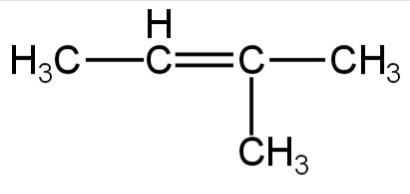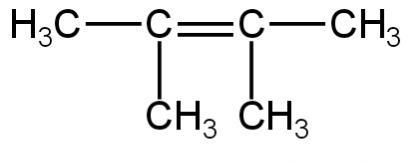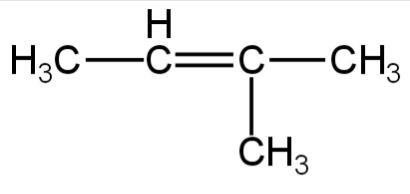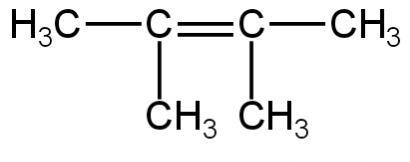
The compounds that will give an isomer of 2,2-dimethylpropane on catalytic hydrogenation are
1.

2.

3.

4.

A. 1 and 4
B. 2 and 4
C. 1 and 3
D. 1 and 2
Answer
221.4k+ views
Hint: 2,2-dimethylpropane has five carbon atoms and is also called neopentane. It is a structural isomer of pentane. It is a double-branched-chain alkane. Structural isomers are the compounds having the same molecular formula but different structures
Complete Step by Step Solution:
Here in this question, we are given some hydrocarbons and we have to find out which one of those will give an isomer of 2,2-dimethylpropane on catalytic hydrogenation.
2,2-dimethylpropane as we know is an isomer of the alkane pentane.
So, the hydrocarbon which will have 5 carbon atoms is the isomer of 2,2-dimethylpropane.
1.

Image: Option 1
This compound on hydrogenation will give 2-methyl butane.
It has five carbon atoms.
So, it is an isomer of 2,2-dimethylpropane.
So, 1 is correct.
2.

Image: Option 2
This compound on hydrogenation will give butane.
So, it is not an isomer of 2,2-dimethylpropane.
So, 2 is incorrect.
3.

Image: Option 3
This compound on hydrogenation will give pentane.
So, it is an isomer of 2,2-dimethylpropane.
So, 3 is correct.
4.

Image: Option 4
This compound on hydrogenation will give 2,3-dimethyl butane. It is an isomer of hexane.
So, 4 is incorrect.
As both options 1 and 3 are correct. So, C is the correct option.
So, option D is correct.
Note: Stereoisomerism is a type of isomerism in which the bonds are similar but the comparative positions of the atoms are different. Enantiomers are a type of stereoisomers that are mirror images of each other that are non-superimposable. These two compounds possess similar physical properties but differ in the path in which they rotate polarised light.
Complete Step by Step Solution:
Here in this question, we are given some hydrocarbons and we have to find out which one of those will give an isomer of 2,2-dimethylpropane on catalytic hydrogenation.
2,2-dimethylpropane as we know is an isomer of the alkane pentane.
So, the hydrocarbon which will have 5 carbon atoms is the isomer of 2,2-dimethylpropane.
1.

Image: Option 1
This compound on hydrogenation will give 2-methyl butane.
It has five carbon atoms.
So, it is an isomer of 2,2-dimethylpropane.
So, 1 is correct.
2.

Image: Option 2
This compound on hydrogenation will give butane.
So, it is not an isomer of 2,2-dimethylpropane.
So, 2 is incorrect.
3.

Image: Option 3
This compound on hydrogenation will give pentane.
So, it is an isomer of 2,2-dimethylpropane.
So, 3 is correct.
4.

Image: Option 4
This compound on hydrogenation will give 2,3-dimethyl butane. It is an isomer of hexane.
So, 4 is incorrect.
As both options 1 and 3 are correct. So, C is the correct option.
So, option D is correct.
Note: Stereoisomerism is a type of isomerism in which the bonds are similar but the comparative positions of the atoms are different. Enantiomers are a type of stereoisomers that are mirror images of each other that are non-superimposable. These two compounds possess similar physical properties but differ in the path in which they rotate polarised light.
Recently Updated Pages
Is PPh3 a strong ligand class 12 chemistry JEE_Main

JEE Main 2025-26 Mock Test: Organic Compounds Containing Nitrogen

JEE Main 2025-26 Organic Compounds Containing Nitrogen Mock Test

Full name of DDT is A 111trichloro22bispchlorophenyl class 12 chemistry JEE_Main

JEE Main Mock Test 2025-26: Purification & Characterisation of Organic Compounds

JEE Main Chemical Kinetics Mock Test 2025-26: Free Practice Online

Trending doubts
JEE Main 2026: Application Form Open, Exam Dates, Syllabus, Eligibility & Question Papers

Derivation of Equation of Trajectory Explained for Students

Hybridisation in Chemistry – Concept, Types & Applications

Understanding the Angle of Deviation in a Prism

How to Convert a Galvanometer into an Ammeter or Voltmeter

Degree of Dissociation: Meaning, Formula, Calculation & Uses

Other Pages
Solutions Class 12 Chemistry Chapter 1 CBSE Notes - 2025-26

NCERT Solutions For Class 12 Chemistry Chapter 1 Solutions - 2025-26

The D and F Block Elements Class 12 Chemistry Chapter 4 CBSE Notes - 2025-26

NCERT Solutions for Class 12 Chemistry Chapter Chapter 7 Alcohol Phenol and Ether

NCERT Solutions ForClass 12 Chemistry Chapter Chapter 8 Aldehydes Ketones And Carboxylic Acids

JEE Advanced Marks vs Ranks 2025: Understanding Category-wise Qualifying Marks and Previous Year Cut-offs




